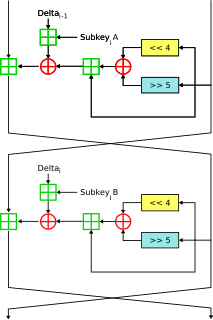Related Research Articles
In cryptography, a block cipher is a deterministic algorithm operating on fixed-length groups of bits, called blocks, with an unvarying transformation that is specified by a symmetric key. Block ciphers operate as important elementary components in the design of many cryptographic protocols, and are widely used to implement encryption of bulk data.
Symmetric-key algorithms are algorithms for cryptography that use the same cryptographic keys for both encryption of plaintext and decryption of ciphertext. The keys may be identical or there may be a simple transformation to go between the two keys. The keys, in practice, represent a shared secret between two or more parties that can be used to maintain a private information link. This requirement that both parties have access to the secret key is one of the main drawbacks of symmetric key encryption, in comparison to public-key encryption.
In cryptography, 3-Way is a block cipher designed in 1994 by Joan Daemen. It is closely related to BaseKing; the two are variants of the same general cipher technique.

Serpent is a symmetric key block cipher that was a finalist in the Advanced Encryption Standard (AES) contest, where it was ranked second to Rijndael. Serpent was designed by Ross Anderson, Eli Biham, and Lars Knudsen.

The GOST block cipher (Magma), defined in the standard GOST 28147-89, is a Soviet and Russian government standard symmetric key block cipher with a block size of 64 bits. The original standard, published in 1989, did not give the cipher any name, but the most recent revision of the standard, GOST R 34.12-2015, specifies that it may be referred to as Magma. The GOST hash function is based on this cipher. The new standard also specifies a new 128-bit block cipher called Kuznyechik.

In cryptography, the Tiny Encryption Algorithm (TEA) is a block cipher notable for its simplicity of description and implementation, typically a few lines of code. It was designed by David Wheeler and Roger Needham of the Cambridge Computer Laboratory; it was first presented at the Fast Software Encryption workshop in Leuven in 1994, and first published in the proceedings of that workshop.

In cryptography, XTEA is a block cipher designed to correct weaknesses in TEA. The cipher's designers were David Wheeler and Roger Needham of the Cambridge Computer Laboratory, and the algorithm was presented in an unpublished technical report in 1997. It is not subject to any patents.

In cryptography, DES-X is a variant on the DES symmetric-key block cipher intended to increase the complexity of a brute-force attack using a technique called key whitening.
In cryptography, Khufu and Khafre are two block ciphers designed by Ralph Merkle in 1989 while working at Xerox's Palo Alto Research Center. Along with Snefru, a cryptographic hash function, the ciphers were named after the Egyptian Pharaohs Khufu, Khafre and Sneferu.
In cryptography, the Cellular Message Encryption Algorithm (CMEA) is a block cipher which was used for securing mobile phones in the United States. CMEA is one of four cryptographic primitives specified in a Telecommunications Industry Association (TIA) standard, and is designed to encrypt the control channel, rather than the voice data. In 1997, a group of cryptographers published attacks on the cipher showing it had several weaknesses which give it a trivial effective strength of a 24-bit to 32-bit cipher. Some accusations were made that the NSA had pressured the original designers into crippling CMEA, but the NSA has denied any role in the design or selection of the algorithm. The ECMEA and SCEMA ciphers are derived from CMEA.
In cryptography, mod n cryptanalysis is an attack applicable to block and stream ciphers. It is a form of partitioning cryptanalysis that exploits unevenness in how the cipher operates over equivalence classes modulo n. The method was first suggested in 1999 by John Kelsey, Bruce Schneier, and David Wagner and applied to RC5P and M6. These attacks used the properties of binary addition and bit rotation modulo a Fermat prime.
The slide attack is a form of cryptanalysis designed to deal with the prevailing idea that even weak ciphers can become very strong by increasing the number of rounds, which can ward off a differential attack. The slide attack works in such a way as to make the number of rounds in a cipher irrelevant. Rather than looking at the data-randomizing aspects of the block cipher, the slide attack works by analyzing the key schedule and exploiting weaknesses in it to break the cipher. The most common one is the keys repeating in a cyclic manner.

In cryptography, the boomerang attack is a method for the cryptanalysis of block ciphers based on differential cryptanalysis. The attack was published in 1999 by David Wagner, who used it to break the COCONUT98 cipher.
In cryptography, integral cryptanalysis is a cryptanalytic attack that is particularly applicable to block ciphers based on substitution-permutation networks. It was originally designed by Lars Knudsen as a dedicated attack against Square, so it is commonly known as the Square attack. It was also extended to a few other ciphers related to Square: CRYPTON, Rijndael, and SHARK. Stefan Lucks generalized the attack to what he called a saturation attack and used it to attack Twofish, which is not at all similar to Square, having a radically different Feistel network structure. Forms of integral cryptanalysis have since been applied to a variety of ciphers, including Hierocrypt, IDEA, Camellia, Skipjack, MISTY1, MISTY2, SAFER++, KHAZAD, and FOX.
In cryptography, KN-Cipher is a block cipher created by Kaisa Nyberg and Lars Knudsen in 1995. One of the first ciphers designed to be provably secure against ordinary differential cryptanalysis, KN-Cipher was later broken using higher order differential cryptanalysis.
In cryptography, Treyfer is a block cipher/MAC designed in 1997 by Gideon Yuval. Aimed at smart card applications, the algorithm is extremely simple and compact; it can be implemented in just 29 bytes of 8051 machine code.
In cryptography, COCONUT98 is a block cipher designed by Serge Vaudenay in 1998. It was one of the first concrete applications of Vaudenay's decorrelation theory, designed to be provably secure against differential cryptanalysis, linear cryptanalysis, and even certain types of undiscovered cryptanalytic attacks.
In cryptography, M8 is a block cipher designed by Hitachi in 1999. The algorithm negotiates introduced in 1997 M6, with the modified key length, which is enlarged to 64 bits or more. This cipher operates with Feistel network and designed to reach high performance on small implementation or 32 bits devices. For instance, by using round numbers = 10 it present encryption speed at 32 Mbps for dedicated hardware of 6K gates and 25 MHz clock or 208 Mbps for program, that uses C-language and Pentium-I 266MHz. Due to the openness of description, it should not be used in open or multivendor software.

In cryptography, Twofish is a symmetric key block cipher with a block size of 128 bits and key sizes up to 256 bits. It was one of the five finalists of the Advanced Encryption Standard contest, but it was not selected for standardization. Twofish is related to the earlier block cipher Blowfish.

Simon is a family of lightweight block ciphers publicly released by the National Security Agency (NSA) in June 2013. Simon has been optimized for performance in hardware implementations, while its sister algorithm, Speck, has been optimized for software implementations.
References
- John Kelsey, Bruce Schneier, David Wagner (March 1999). Mod n Cryptanalysis, with Applications Against RC5P and M6 (PDF/PostScript). 6th International Workshop on Fast Software Encryption (FSE '99). Rome: Springer-Verlag. pp. 139–155. Retrieved 25 January 2007.CS1 maint: multiple names: authors list (link)
- David Wagner, Alex Biryukov (1999). "Slide Attacks" (PostScript). Retrieved 25 January 2007.Cite journal requires
|journal=(help)
| This cryptography-related article is a stub. You can help Wikipedia by expanding it. |